Soft tile roof ventilation: design and installation of soft roofs
Soft tile roofing is known for its excellent performance, but it has the only drawback - the lack of adequate ventilation. So, a regular accumulation of condensate under the roof destroys the insulation, wooden rafters and crates, which casts doubt on the safety of the building.
Agree, it is better to think about installing a roof ventilation before buying a roof covering than then spend a lot of money on restoring the roof structure. Plus, ventilation of the roof from soft tiles will forever solve the problem of mold formation indoors. After all, such a neighborhood has not brought any benefit to anyone.
Before starting the design of roof ventilation, you should study in more detail all the methods of air exchange, including the installation features of each of them. Later in the article you will learn what type of ventilation is better to choose, and what rules it is important to adhere to at the stage of designing and arranging a ventilation system.
The content of the article:
Roof ventilation - why is this important?
Since due to sudden changes in air temperature, numerous fumes inside the room and high humidity, condensation forms in the under-roof space.
So, the accumulated moisture penetrates the insulating layer, which leads to a decrease in its effectiveness.

In addition, the lack of necessary air exchange leads to a significant overheating of the roof in the hot season, which is why it will be unbearable to be indoors.
Therefore, the installation of a roof ventilation system allows you to solve several problems at once, providing:
- sufficient fresh air in roof space;
- stable temperature and humidity in the attic;
- reliable protection of the roof, floor and walls from the formation of mold;
- full functioning of the insulating material.
Installing ventilation for the roof will significantly reduce the cost of heating or cooling the premises, replacing the rafter system or numerous attempts to combat fungus.
The ideal time to install a ventilation system is to replace the old cover with a new roof from soft tiles.
Roof Venting Requirements
The proper ventilation device for soft tile roofs should be taken seriously to avoid the above problems.
First of all, remember the space between the base and insulation, to achieve which you will need to fill a beam with a thickness of 5 cm. In addition, it is important to worry in advance that there should be small openings at the bottom of the ramp to ensure a sufficient influx of fresh air.
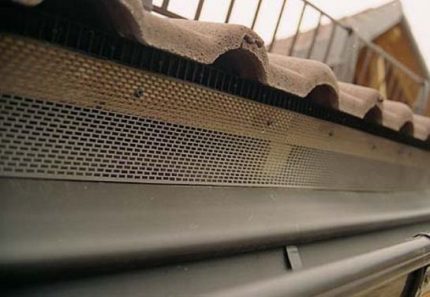
During the installation of the soft roof, do not forget about the openings for ridge ventilation and aerator installation.
When installing the crate, it is important to take into account the need for gaps, due to which continuous air circulation will be ensured. All these nuances should be considered at the stage of system design.
Varieties of ventilation for the roof
The shape and design of the roof completely determine the type of roof ventilation. If a soft tile roof has a complex geometric surface, sufficient air exchange can only be achieved by means of ridge ventilation equipment.
So, depending on the features of building a house, there are two types of ventilation through the ventilation ridge:
- Spot. It is installed in separate areas of the ridge or slope, while it has a mushroom shape. Such aerators are often integrated into the general ventilation system of buildings, but in some cases they can be equipped with a separate hood.
- Continuous. It is mounted along the entire ridge, and thereby provides complete ventilation of the space under the roof space. Unlike a point system, continuous ventilation is more effective for a soft roof.
In this case, it is worth considering a continuous type of ventilation. So, the ridge element is a rigid plastic structure, which consists of a solid upper part in the form of a corner, as well as perforated walls.
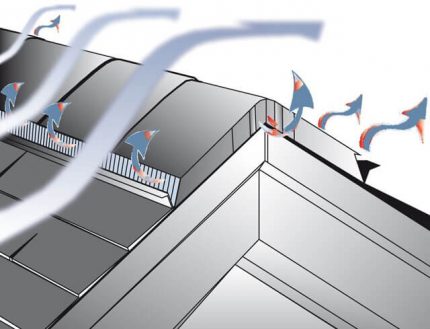
Skate ventilation works by convection, in which warm air masses rise up from the cornice, and cold air, in turn, is pulled down. In this case, the system has its own entry and exit zones.
So, fresh air enters the under-roof space through the roof overhangs of the ventilation (bottom), while the ridge aerator, located at the top of the soft roof, is the outlet for the exhaust air.
Rules for installing the ridge system
Since the ridge version is the most reliable type of roof ventilation to date, it is worth considering in more detail.
Regardless of the type of ridge aerator, all structures have the same structure, and include such components:
- protective barrier;
- connecting endings;
- partitions;
- structural ribs.
To carry out the installation of the structure, it is necessary to make several grooves in the ridge beam, 1.5 cm long. The distance between them should not be less than 30 cm. The marked grooves will be further covered by the ridge element.
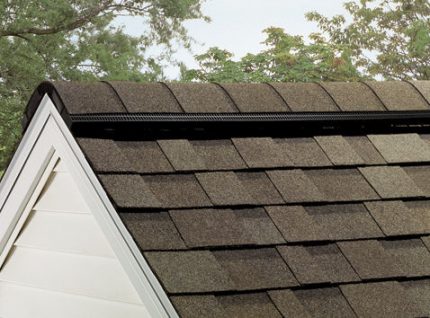
Ready-made designs for installing ridge ventilation can now be purchased at any store, and an element is selected in accordance with the angle of the roof.
If you have a finished skate product, you need to figure out how to put vents on the roof of soft tiles:
- if the system will be installed on the finished roof from a flexible tile, then, first of all, you will need to dismantle the old ridge, partially dismantling the tile;
- then it is necessary to mark the new ridge aerator, while it is important to make an allowance of 1.5 cm from the top;
- at the next stage, you need a circular saw, with which you can make a neat cut, relying on the markup;
- flexible tiles will be nailed to the whole areas, but the partitions in this case should be left open;
- There are special latches on the ridge aerator, through which the element will be connected to the ridge of the roof. Having installed the aerator by means of small latches, it will need to be fixed with the help of small screws;
- for greater reliability, the end part of the aerator should be treated with silicone sealant;
- then the installed profile will need to be covered with soft tiles.
Despite the popularity of the do-it-yourself method, in some cases it would be more advisable to purchase a finished design than to undertake its independent production.
The cost of ventilation ridge systems is not so high as to try to save on their purchase.
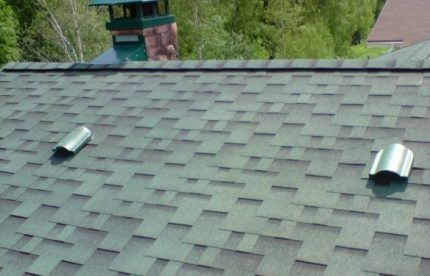
In large houses, in addition to continuous roof ventilation, a point ventilation system is also installed for roofing from soft tiles, because often continuous roof ventilation is not enough.
The consequences of the lack of roof ventilation
In the absence of a ventilation system, moisture can accumulate under the roof from the bituminous tiles in the hollow space, due to which the roof will begin to rot, which means that the structural strength will significantly decrease. In addition, the lack of proper air exchange will lead to wetting of the insulation, because of which its heat-insulating properties will be violated.
Roof ventilation plays a particularly important role in the winter season, when snow lingers on the roof. So, under the influence of warm steam, “stuck” in the under-roof space, the snow begins to gradually melt and turn into ice. Such ice accumulations can lead not only to leakage, but also to malfunction gutter systems.

The installation of the ridge ventilation system allows you to artificially create a convective flow of air mass between the cornice and the ridge, so that warm air will not be trapped under the roof.
Another plus - unlike point ventilation, the ridge aerator can be masked with soft tiles without violating the integrity of the structure.
Conclusions and useful video on the topic
You can figure out how to properly install the ridge ventilation on the roof with your own hands through the following video:
Ventilation of a roof from a tile allows not only to solve the problem of condensate accumulation in the under-roof space, but also to save on heating or cooling the premises, depending on the external temperature.For a soft roof, a ridge aerator is ideally suited, providing an affordable exit of exhaust air masses and an influx of fresh air into the roof.
If you had to independently mount a ridge aerator for ventilation of a soft roof, then please tell us your story. Your experience can help many of our readers determine the type of roof ventilation and correctly install the system with their own hands. You can leave a comment in a special field located directly under the article.

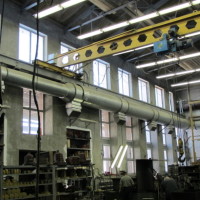 Ventilation of a room with gas-using equipment: design standards + arrangement rules
Ventilation of a room with gas-using equipment: design standards + arrangement rules 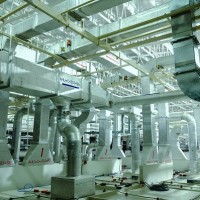 Requirements for ventilation of public buildings: subtleties of arrangement and design of ventilation
Requirements for ventilation of public buildings: subtleties of arrangement and design of ventilation  Ventilation and air conditioning for medical institutions: rules and features of the arrangement of ventilation
Ventilation and air conditioning for medical institutions: rules and features of the arrangement of ventilation  Cleanroom ventilation: design and installation rules for ventilation systems
Cleanroom ventilation: design and installation rules for ventilation systems 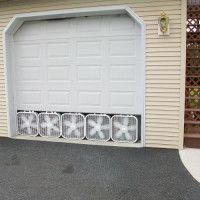 DIY garage ventilation: an overview of the best options for arranging an air exchange system
DIY garage ventilation: an overview of the best options for arranging an air exchange system  Ventilation in the house from sip panels: the best options and layouts
Ventilation in the house from sip panels: the best options and layouts  How much does it cost to connect gas to a private house: the price of organizing gas supply
How much does it cost to connect gas to a private house: the price of organizing gas supply  The best washing machines with dryer: model rating and customer tips
The best washing machines with dryer: model rating and customer tips  What is the color temperature of light and the nuances of choosing the temperature of the lamps to suit your needs
What is the color temperature of light and the nuances of choosing the temperature of the lamps to suit your needs  Replacement of a geyser in an apartment: replacement paperwork + basic norms and requirements
Replacement of a geyser in an apartment: replacement paperwork + basic norms and requirements